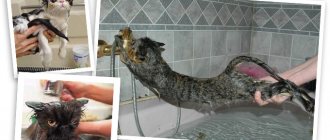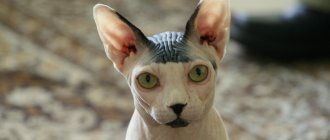The Sphynx's ears and eyelids are not protected by hairs, so they get dirty faster than those of cats of other breeds. Not only dust penetrates inside, but also pathogenic microorganisms that can cause inflammation. To prevent this from happening, Sphynx cats need regular cleaning of their ears and eyes.
Let's find out with what frequency and how to carry it out correctly and how to prepare the cat for an unpleasant procedure.
How difficult is it to care for a Sphynx?
Unlike cats with coats, hairless cats require more careful and frequent grooming. If you don’t take care of your Sphynx’s skin, the animal can develop fungal diseases, which can sometimes take a long time and be difficult to treat.
It's all about the large amount of fat secreted by the skin of sphinxes. Dirt sticks to the greasy film covering the cat's body, and it all rolls into the folds of the skin, where pathogenic bacteria successfully multiply. And if this dirt is not washed off periodically, then inflammation of the skin begins with all the ensuing consequences (fungal diseases, ulcers, etc.). This is why hairless cats are recommended to be washed at least once a week or wiped with hypoallergenic wet wipes for sensitive skin or with aloe vera. Too much oil production may indicate that the cat is not eating properly (for example, too much fatty food in the diet) or that the cat is not feeling well. Sphynx cats have no (or very little) hair in their ears, which makes them more prone to collecting dirt. Sphynx ears also produce large amounts of earwax. Mixing with dirt and clogging the ear canals, excess wax prevents the ear from “breathing” and the development of otitis media begins. If this condition is not noticed in time, then external otitis may develop into internal, which is especially dangerous, since the cat may lose hearing, or even worse.
Why should you clean your cat's ears?
Cats, like humans, have wax buildup in their ears. This secretion is produced by the ceruminous glands. Its main function is to lubricate and protect the ear canals from dirt, fungal and bacterial infections.
The amount of sulfur varies from animal to animal. In some cats, the glands work more intensely, so more secretions are produced. If too much of it is released, it can cause traffic jams. Blockage of the ear canal can cause inflammation. This is why it is important to periodically clean the ears of indoor cats.
This is interesting! Sulfur can destroy some strains of E. coli, staphylococci and streptococci. However, with a decrease in immunity, its bactericidal properties weaken.
Sphynxes have completely open hearing organs, not protected by hairs of fur, which is why dust particles, pathogenic microorganisms and insects easily get inside them. Therefore, they need to be cleaned regularly. Due to poor care, representatives of this breed, especially kittens, often suffer from ear scabies and otitis media.
How often and with what should you wash your Sphynx?
As stated above, Sphynx cats need to be washed at least once a week. If this is not possible, then wipe the animal with damp baby wipes (or special wipes for animals). Particular attention is paid to the folds on the muzzle and the places between the toes.
For washing, use shampoos designed specifically for hairless cats. From reviews of Sphynx owners, they use a variety of means for bathing. Here are some of them: Bayer HyLyt® Shampoo, Organic Pet Shampoo Sphynx Cat, Malaseb Pet Shampoo (medicated shampoo with an antifungal effect, helps treat any fungal or bacterial diseases, preferably used only as needed), Allerpet Cat Dander Remover, Zymox Shampoo, Alba Botanica Natural Hawaiian Coconut Shampoo and Conditioner, Earthbath All Natural Hypo-Allergenic and Fragrance Free Cat Wipes.
Some Sphynxes are unnerved by the sound of running water, so it is better to pour water into the bath in advance. Place a mat on the bottom of the bath (to prevent the cat from slipping its paws) and fill with warm water. The water level should be up to the cat's stomach. Prepare a dry towel. Gently place the cat in the bath. Lather your pet, paying special attention to the belly, back of the legs and between the toes. Do not wet your head, but wipe it with a damp sponge. Then rinse your Sphynx and wrap him in a towel. After the bath, some breeders recommend applying a shea butter-based body butter or lotion to the skin.
Cleaning a kitten's ears
The specific structure of kittens' ears does not allow them to clean their ears on their own. Cleansing should be carried out by turning the ear outward with the lining and adhering to the general pattern. Too frequent interventions will lead to impaired immunity of the Sphynx kitten, which will provoke the occurrence of ear diseases. The optimal period for treating ears is once every 2 weeks.
Strict adherence to the technology for cleaning the ears of sphinxes will help prevent the development of ear diseases in an environment favorable for their reproduction. Clean ears will ensure the comfort and health of your pet.
Did you like the article?
How to care for your Sphynx's eyes?
Eye care for hairless cats is usually no different from eye care for other breeds. Every day it is necessary to remove discharge from the eyes with a clean gauze cloth (use a separate cloth for each eye) soaked in boiled cool water or a special eye lotion. Some breeders recommend rinsing the eyes using sterile wipes soaked in saline solution. In healthy cats, the discharge is clear or slightly brownish and gelatinous. If the discharge is whitish or yellowish, this may indicate an infection. In this case, consult your veterinarian.
What to pay attention to during the cleaning process
Now you know how to clean a cat’s ears and how to clean a cat’s ears so that everything goes smoothly. As it turned out, the procedure does not require special knowledge, does not last long, and is not accompanied by pain or severe discomfort. At the same time, there are situations when it is impossible to carry out hygiene measures without the help of a veterinarian:
- the cat suffers from hearing impairment;
- the integrity of the auricle is compromised as a result of injury;
- there is a fungal infection, there is an inflammatory process;
- there is a suspicion of ear mites;
- there is a white coating, spots, rashes inside;
- There is an unpleasant fetid odor and copious discharge.
In addition, doctors do not recommend cleaning cats’ ears if the pet often shakes its head, scratches its ears, tilts its head to the side when walking, and exhibits other alarming symptoms.
In such cases, cleaning cats’ ears on their own is contraindicated; the animal must be urgently shown to a veterinarian who knows for sure how to wash a cat’s ears. The doctor will examine the auricle with an otoscope, assess its condition, and, if necessary, prescribe laboratory tests and additional studies.
How to care for the skin of a Canadian Sphynx?
Unlike other cat breeds (which only have sweat glands on their paw pads), hairless cats sweat throughout their entire body. Therefore, during the hot season, they must be periodically wiped with a damp cloth (flannel) when they become too sweaty. Some breeders recommend moisturizing the skin with a gentle lotion or unscented oil (check with your veterinarian about which one).
Don't forget about caring for your chin, where acne often appears. To treat acne, wash your chin with warm water and mild antibacterial soap, then wipe with Witch Hazel ointment on a cotton pad and rinse with cool water. Depending on the severity of the acne, your veterinarian may recommend the use of benzoyl peroxide. If acne is left untreated, inflammation of the hair follicles may develop, which will require more serious medical attention.
Differences between Sphynx cats and regular cats
Special thermoregulation
The body temperature of an adult animal is about 38 °C. Hairless skin has a high level of heat transfer, so it feels hot to the touch. Cold is contraindicated for Sphinxes. They love to sleep under a blanket with their owner and look for warm places in the house. In winter, your pet may even need clothes. In summer, hairless skin is not protected from ultraviolet radiation in any way, and the cat can get sunburned, so sun exposure should be moderate. Sphynx cats spend a lot of energy maintaining their body temperature. Compared to furry cats, they require more calories.
Lack of eyelashes
Eyelashes are also hair, they are just stiffer and grow along the edge of the eyelids in order to protect the cornea of the eye from contamination, foreign bodies and damage. Accordingly, sphinxes do not have this hair either. To compensate for the lack of eyelashes, cats of this group of breeds produce more tear secretion that washes the eye. There is so much of it that it cannot all escape through the nasolacrimal duct. That's why sphinxes periodically “cry.” When exposed to air, tears oxidize and turn brown. It looks like mucous brownish lumps in the inner corners of the eyes, so regular hygiene procedures are recommended.
Special skin secretion
To protect their hairless skin, Sphynx cats have many sebaceous glands. As a result, the animal becomes covered with grease, which leaves marks on the palms, clothes, and bedding. It is because of this feature that such cats need regular bathing: if too much sebum is produced, the glands can become clogged, which can lead to acne, pimples and inflammation on the Sphynx's skin.
How to care for the claws of the Canadian Sphynx?
Sphynx claws need to be trimmed twice a month with special claw clippers. If you have never trimmed a cat's claws, before starting the procedure, watch a training video (YouTube can help). It is easiest to trim nails after bathing; they become softer.
Article on the topic Canadian Sphynx
Since Sphynx cats lack hair, oil accumulates not only on the fur and ears, but also at the base of the claws and on the claws themselves. Therefore, the claws need to be cleaned. For this procedure you will need a soap solution, an old natural bristle toothbrush, a bowl of warm water and a towel. The brush is moistened in a soapy solution, pressed on the finger so that the claw comes out entirely, and each claw and its base are thoroughly cleaned separately. After cleaning all the claws on the paw, rinse it in warm water and wipe it dry with a towel. The claws on the hind paws receive more attention than those on the front paws. Sphynx cats should have their claws cleaned at least twice a month.
Examination of the animal before the procedure
A Sphynx cat's ears need to be cleaned regularly, but the physiological characteristics of the pet must be taken into account. Regular examination of the Sphynx will help determine the need for the procedure. You need to check the condition of your hearing organs weekly.
This approach will help to detect otodectosis infection, the development of purulent otitis media and other problems in time. Owners of Sphynx cats usually inspect their ears before bathing them.
To assess the condition of the ears, you will need good lighting. The cat should be placed on a flat surface, pressed lightly, the head should be fixed, and the shell should be turned inside out. You need to act carefully, you should not allow rough and sudden movements, so as not to frighten your pet.
It is normal to have wax inside the ear. In a healthy cat, it has the consistency of a paste and is colored light brown. The secretion is evenly distributed over the inner surface of the sink and does not have an unpleasant odor.
There are no scratches on the scalp or ears, and no ichor or other fluid is released from the ear canal. But there are other situations.
What should you be wary of?
If, during examination or during cleaning, too much sulfur is detected, although this has not been noticed before, it means that some changes have occurred in the pet’s body. This may be due to metabolic disorders, allergies or ear inflammation.
During the inspection, you should pay attention to the following factors:
- Change in color of sulfur. When infected with otodectosis, it acquires a dark brown tint.
- The presence of discharge and foul odor from the ear, the appearance of greenish crusts in the ear canal. This happens with purulent otitis media.
- Scratches on the outer and inner surfaces of the sinks. This indicates itching.
- The Sphinx behaves restlessly, tilts its head, shakes it, and sleeps poorly.
In some cats, almost no wax is formed, and the inside of the ears looks dry and even flaky. This may mean that there is not enough fat in the animal's diet.
For any of these problems, it is better to consult a veterinarian. You cannot clean the ears of a sphinx at home if there is purulent inflammation, this is dangerous.
Ear wax in a cat
If you thought that it was for performing magical rituals, then you are partly right. The magic lies in the amount and color of sulfur, which can be used to tell whether your animal is healthy or whether a visit to the doctor is coming.
A lack of sulfuric substance or its excess indicates either improper care of the fluffy, or a malfunction of the body, or a disease.
Sulfur is necessary to cleanse the outer ear of various “garbage”:
- dust;
- small particles of hair and skin;
- spores of pathogenic fungi;
- viruses and bacteria;
- body waste.
All this debris, falling on the ear lining, covered with a thin layer of secretion from 2000 modified sebaceous glands located inside the ear canal, clumps up and is expelled naturally. Warm wax is evenly distributed throughout the ear, from where the cat easily removes it while washing.
By the way, such glands are located evenly throughout the cat’s body; they provide lubrication to the animal’s fur and skin, that is, they also perform a protective function.
Cat earwax contains more than 10 peptides that prevent the development of various fungi and bacteria.
It is believed that sulfur secretion prevents small insects from entering the ear. Self-cleaning of the ear canal is a natural, genetically determined process. Violation of this process indicates disorders in the cat’s body, for example, decreased immunity.











